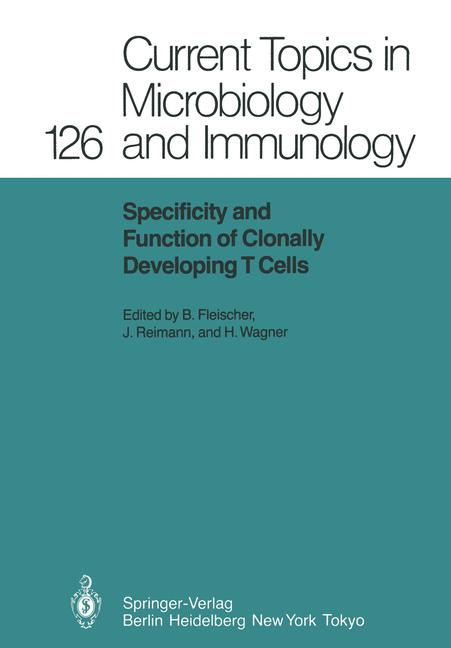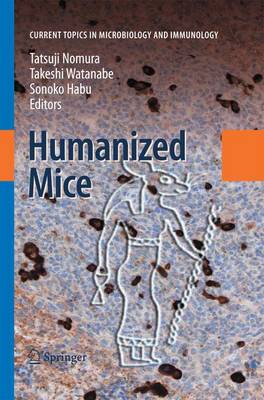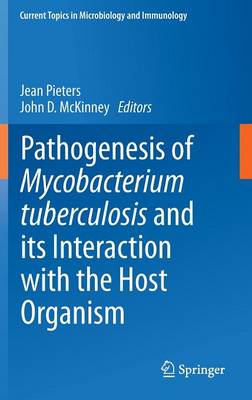(To see other currencies, click on price)
MORE ABOUT THIS BOOK
Main description:
The international workshop on "Specificity and Function of Clonally Developing T Cells" was held at SchloG Rei- sensburg (near UIm, West Germany) on March 17-20, 1985. The meeting brought together immunologists study- ing clonal T-cell development in man and mouse in various in vitro systems at the cellular as well as molecular level. It was an attempt to provide an overview of the current research interests of groups working on (a) the developmen- tal potential of in vitro expanding primary T-cell clones (investigated using limiting dilution analysis) and cloned T -cell lines established in long-term culture; (b) the signals required for the expression of particular patterns of (func- tional and antigen receptor) phenotypes by T cells which are either freshly explanted in vitro, or maintained in vitro as cloned long-term lines; and (c) the generation of an MHC-restricted T-cell repertoire. In the study of thymocytes emphasis has shifted towards the presumably immature adult/embryonic subset(s) which is (are) devoid of subset-specific differentiation markers (L3T4, Lyt-2).
Neither the signal requirement(s) for clonal expansion in vitro of these cells, nor their precursor role for any functional T -cell lineage are as yet unambiguously established. The multiple modes of human T-cell activation (e.g., via Tp44, T11, T3/Ti molecular complexes) were em- phasized by a number of presentations and raised the ques- tion of whether these different modes of activation induce different functional activities in individual T-cell clones.
Contents:
A: Development of T Lymphocytes in the Thymus.- Introductory Remarks.- Development of T Lymphocytes Within the Thymus and Within Thymic Nurse Cells. With 3 Figures.- Thymus Development.- Major Histocompatibility-Restricted Cytolytic T-Lymphocyte Precursors from the Thymus of In Vivo Primed Mice: Increased Frequency and Resistance to Anti-Lyt-2 Antibody Inhibition. With 1 Figure.- Thymic Stem Cells: Their Interaction with the Thymic Stroma and Tolerance Induction.- B: Murine T-Cell Receptor Genes.- Organization, Rearrangement, and Diversification of Mouse T-Cell Receptor Genes. With 1 Figure.- Expression of T-Cell Receptor by a Mouse Monoclonal Antigen-Specific Suppressor T-Cell Line.- Somatic Variation of Antigen-Recognition Specificity in H-2b-TNP-Specific Cytotoxic T-Cell Clones.- The Change of Specificity, Karyotype, and Antigen-Receptor Gene Expression is Correlated in Cytotoxic T-Cell Lines.- C: Phenotype and Functional Potential of T-Cell Clones.- Introductory Remarks.- A Study of the Functional Potential of Mouse T-Cell Clones.- Generation, Propagation, and Variation in Cloned, Antigen-Specific, Ia-Restricted Cytolytic T-Cell Lines.- Significance of T4 or T8 Phenotype of Human Cytotoxic T-Lymphocyte Clones. With 1 Figure.- Natural and Unnatural Killing by Cytolytic T Lymphocytes. With 2 Figures.- Acquisition of Suppressive and Natural Killer-Like Activities Associated with Loss of Alloreactivity in Human "Helper" T-Lymphocyte Clones. With 3 Figures.- Expression and Function of Class II I-Ak Antigens on an Antigen-Specific T-Suppressor Cell Clone. With 2 Figures.- D: Signal Requirements for T-Cell Activation.- Introductory Remarks.- Heterogeneity of the Signal Requirements During the Primary Activation of Resting Lyt-2+ Cytotoxic T-Lymphocyte (CTL) Precursors into Clonally Developing CTL. With 2 Figures.- Regulation of Lytic Function by Recombinant IL2 and Antigen. With 4 Figures.- The Target Structure for T11: A Cell Interaction Molecule Involved in T-Cell Activation? With 3 Figures.- Antigen- and Lectin- Sensitized Murine Cytolytic T Lymphocyte- Precursors Require Both Interleukin 2 and Endogenously Produced Immune (?) Interferon for Their Growth and Differentiation. With 3 Figures.- Activation Requirements for Resting T Lymphocytes.- E: Self-Nonself Discrimination in the T-Cell Compartment.- Introductory Remarks.- Functional Clonal Deletion and Suppression as Complementary Mechanisms in T Lymphocyte Tolerance.- Human T Cell Clones, Tolerance, and the Analysis of Autoimmunity. With 1 Figure.- Antiself Suppressive (Veto) Activity of Responder Cells in Mixed Lymphocyte Cultures. With 6 Figures.- Analysis of T Suppressor Cell Mediated Tumor Escape Mechanisms. With 2 Figures.- The T-Cell Receptor Recognizes Nominal and Self Antigen Independently. A Theoretical Alternative to the Modified Self Concept. With 3 Figures.- F: T-Cell-Mediated Autoreactivity.- Introductory Remarks.- T-Cell Reactivity to Polymorphic MHC Determinants. I. MHC-Guided T-Cell Reactivity.- T-Cell Reactivity to Polymorphic MHC Determinants. II. Self-Reactive and Self-Restricted T Cells. With 6 Figures.- T-Cell Reactivity to Polymorphic MHC Determinants. III. Alloreactive and Allorestricted T Cells. With 9 Figures.- Appearance of New Specificities in Lectin-Induced T-Cell Clones Obtained from Limiting Dilution T-Cell Cultures. With 2 Figures.- Syngeneic Cytotoxicity and Veto Activity in Thymic Lymphoid Colonies and Their Expanded Progeny. With 4 Figures.- Functional Analysis of a Self-I-A Reactive T-Cell Clone Which Preferentially Stimulates Activated B Cells.- Indexed in Current Contents.
PRODUCT DETAILS
Publisher: Springer (Springer-Verlag Berlin and Heidelberg GmbH & Co. K)
Publication date: November, 2011
Pages: 336
Weight: 581g
Availability: Available
Subcategories: Immunology, Microbiology
From the same series
Eric Vivier
Kevin V. Morris
Esteban Domingo
Eric Vivier
Tomohiro Kurosaki
Christian Munz
Christian Munz
Michael G. Katze
Bryan R. Cullen
David S. Goodsell
G. Singh Chhatwal
Ralf Bartenschlager
Ellen Heber-Katz
Andreas Rummel
Juan J. Lafaille
Thomas E. Shenk
Ben Adler
Michael B. A. Oldstone
Friedrich Koch-Nolte
Marco Falasca
Michael B. A. Oldstone
Benhur Lee
Freddy Radtke
Klaus Aktories
Jean Langhorne
Michael B. A. Oldstone
Jeremy Nuttall
Robert N. Eisenman
Z F Fu
Peter K. Vogt
Tatsuji Nomura
Wilfried Ellmeier
Marc Daeron
H. Koprowski
Hilary Koprowski
Simon Fillatreau
G. Balakrish Nair
Harris G. Fienberg
Michael B. A. Oldstone
R.M.E. Parkhouse
Lars B. Olding
Charles L. Sawyers
Cornelis Murre
Nicholas Mantis
Pamela A. Kozlowski
Charles E. Samuel
Larry J. Anderson
Kenneth Palmer
Marcel B.M. Teunissen
Rudolf Valenta
M.B.A. Oldstone
Thomas Boehm
Cesare Montecucco
Michael B.A. Oldstone
Hubert Hilbi
Hilary Koprowski
Hung Y. Fan
Walter Doerfler
Polly Roy
Michael Karin
Bryan R. Cullen
Glenn Dranoff
Rafi Ahmed
Jurgen A.. Richt
Ulrich Dobrindt
Ellen Heber-Katz
G. Singh Chhatwal
Ralf Bartenschlager
Peter K. Vogt
Robert L. Coffman
Michael G. Katze
Harald Stenmark
Andreas Rummel
Christian Rommel
Fritz Melchers
H. Koprowski
Didier Trono
Uwe Gross
Christian Rommel
M. Celeste Simon
John E. Johnson
K. Takada
Ellen Heber-Katz
C. Schmaljohn
Axel Rethwilm
Jerry L. Workman
Louis B. Justement
Marco Falasca
P.K. Vogt
Michael N. Hall
M.B.A. Oldstone
K. Hirai
Eric Vivier
Allison Abendroth
Oystein Bruserud
Carolyn Wilson
Freddy Radtke
Benhur Lee
Klaus Aktories
Harald Zur Hausen
J.S. Mackenzie
Adrienne E. Clarke
Stefan H.E. Kaufmann
Bernhard Fleischer
Michael Potter
H. Koprowski
H. Koprowski
Rolf Jessberger
Charles L. Sawyers
Chihiro Sasakawa
Vojo Deretic
Alan L. Rothman
Marco Colonna
H. Koprowski
Karl Maramorosch
H. Koprowski
Eckhard R. Podack
Paul Spearman
Takashi Saito
H. Koprowski
W. Doerfler
Michael Loos
H. Koprowski
Daniel Kolakofsky
H. Koprowski
H. Koprowski
Michael Potter
Kenneth I. Berns
H. Koprowski
J. Lindsay Whitton
Fritz Melchers
Nicholas Mantis
Cornelis Murre
Pamela Kozlowski
Klaus Aktories
Fritz Melchers
O. Haller
Peter K. Vogt
Norman L. Letvin
Dan R. Littman
Michael Potter
Robert F. Ramig
Gillian M. Griffiths
H. Koprowski
David Gray
T.A. Trautner
Michael B. A. Oldstone
Jiri Mestecky
Richard W. Moyer
Fritz Melchers
Michael B. A. Oldstone
Guido Kroemer
Hilary Koprowski
H. Koprowski
Peter K. Vogt
Bruce W. Chesebro
Charles J. Parker
P.J. Sansonetti
H. Koprowski
Rolf Knippers
Walter Doerfler
Klaus Jann
Virginia L. Miller
Marie H. Kosco-Vilbois
Peggy J. Farnham
Peter M Schlag
Thomas M. Shinnick
Hilary Koprowski
Anthony J. Pawson
Walter Doerfler
Peter K. Vogt
Klaus Jann
Vincent R. Racaniello
Nicholas Muzyczka
Mark Bothwell
Volker Ter Meulen
Jean-Pierre Kraehenbuhl
Michael B. A. Oldstone
P.H. Hofschneider
Steinunn Baekkeskov
H. Koprowski
F. Melchers
Garnett Kelsoe
Arthur E. Frankel
Michael B. A. Oldstone
Michael B. A. Oldstone
Peter Sarnow
Hermann Wagner
Rudolf Rott
H.L. Robinson
Fritz Melchers
John J. Holland
Jeffrey L. Dangl
Richard W. Compans
Charles Mackay
Beat A. Imhof
H. Koprowski
P.K. Vogt
H. Koprowski
P.A. Bachmann
P.K. Vogt
W. Doerfler
H. Koprowski
P.K. Vogt
Leslie Hudson
Michael Potter
Fritz Melchers
Michael B. A. Oldstone
William S. Mason
Peter K. Vogt
H. Koprowski
P.K. Vogt
Melvin J. Bosma
James K. McDougall
Stefan H.E. Kaufmann
N.J. Dimmock
Peter K. Vogt
Michael B. A. Oldstone
Walter Orenstein
Hans-Georg Krausslich
Fritz Melchers
Christa E. Muller-Sieburg
John D. Lambris
Siamon Gordon
Hermann Wagner
H. Koprowski
Hilary Koprowski
D.B. Willis
Walter Doerfler
A. J. Shatkin
P.K. Vogt
Christopher J. Paige
Michael Potter
Michael B. A. Oldstone
W. Doerfler
Henry C. Wu
Michael B. A. Oldstone
H. Koprowski
H. Koprowski
H. Koprowski
H. Koprowski
Barry T. Rouse
H. Koprowski
Fritz Melchers
H. Koprowski
H. Koprowski
H. Koprowski
H. Koprowski
Charles E. Samuel
F. Melchers
H. Koprowski
H. Koprowski
H. Koprowski
Hans-Dieter Klenk
David W. Weiss
U.H. Koszinowski
Ernst-L. Winnacker
Steven Tracy
L. Du Pasquier
Michael B. Kastan
H. Wagner
Fritz Melchers
Ursula Gunthert
T. Ulf Westblom
P.K. Vogt
Lena Claesson-Welsh
C.H. Hagedorn
Stanley B. Prusiner
Wolfgang Baumeister
Bruce Beutler
Louis B. Justement
Ursula Gunthert
Marcel B.M. Teunissen
Rudolf Valenta
Michael Karin
Glenn Dranoff
Rafi Ahmed
Inger Helene Madshus
Lyubomir T. Vassilev
Martin L. Privalsky
Walter Doerfler
Alexander Steinkasserer
Dennis R. Burton
T.M. Koehler
Jurgen A.. Richt
Walter Doerfler
David A. Harris
Yoshihiro Kawaoka
Paula M. Pitha
Branch D. Moody
Scott Dessain
James L. van Etten
Michael B. A. Oldstone
Tony Romeo
Rafi Ahmed
Steven Tracy
Harald Zur Hausen
Michael B. A. Oldstone
Thomas E. Lane
Tasuku Honjo
Marianne Manchester
Walter Doerfler
Diane E. Griffin
Mark Marsh
Alexander V. Karasev
Dorian McGavern
B. W. J. Mahy
Riccardo Dalla-Favera
Sanjeev Krishna
Patrice Boquet
Klaus Aktories
Luis Enjuanes
Christian Rommel
Christian Rommel
M. Celeste Simon
John E. Johnson
Oystein Bruserud
Allison Abendroth
Peter E. Lipsky
Walter Doerfler
Stanley A. Plotkin
John L. Casey
William M. Shafer
Esteban Domingo
Eric Vivier
Takashi Saito
Paul Spearman
Chihiro Sasakawa
Alan L. Rothman
Vojo Deretic
Walter Orenstein
Dorian McGavern
Alexander V. Karasev
Harald Zur Hausen
Michael B. A. Oldstone
Michael B. A. Oldstone
James L. van Etten
Marianne Manchester
Thomas E. Shenk
Tatsuji Nomura
Tony Romeo
Steven Tracy
Peter K. Vogt
Scott Dessain
Paula M. Pitha
D.B. Moody
Peter K. Vogt
Robert A. Weiss
Rafi Ahmed
Stanley A. Plotkin
Tasuku Honjo
Walter Doerfler
William M. Shafer
John L. Casey
Peter E. Lipsky
Thomas E. Lane
Robert N. Eisenman

































































































































































































































































































































































































































